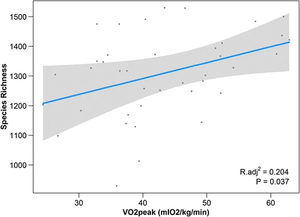Impact of Exercise on the Gut Microbiome: Difference between revisions
No edit summary |
No edit summary |
||
| Line 25: | Line 25: | ||
<br> The repeated citation works like this, with a forward slash.<ref name=aa/> | <br> The repeated citation works like this, with a forward slash.<ref name=aa/> | ||
== | ==Intro== | ||
Exercise is a common form of health regulation. It is known to bring many positive impacts including weight loss, improved cardiovascular health, improved mental health, symptomatic reduction or prevention of chronic diseases including morbid obesity and inflammatory bowel disease (IBS), and other contributors to overall quality of life. The mechanisms by which exercise stimulates these effects in the body are complex. One increasingly popular area of research is the gut microbiome and how the physiological changes may be due to changes in the gut microbial population, in turn affecting the diversity, species prevalence, and products used by the rest of the body. Over the past decade and a half, research has been conducted in an attempt to determine the effect of exercise on the microbiome. Published animal and human studies using both cross-sectional and longitudinal approaches have elucidated certain outstanding correlations (Mailing). | |||
===Bold=== | ===Bold=== | ||
Revision as of 00:34, 19 April 2022
Section

By
Emi Loucks
At right is a sample image insertion. It works for any image uploaded anywhere to MicrobeWiki.
The insertion code consists of:
Double brackets: [[
Filename: PHIL_1181_lores.jpg
Thumbnail status: |thumb|
Pixel size: |300px|
Placement on page: |right|
Legend/credit: Electron micrograph of the Ebola Zaire virus. This was the first photo ever taken of the virus, on 10/13/1976. By Dr. F.A. Murphy, now at U.C. Davis, then at the CDC. Every image requires a link to the source.
Closed double brackets: ]]
Other examples:
Bold
Italic
Subscript: H2O
Superscript: Fe3+
Sample citations: [2]
[3]
A citation code consists of a hyperlinked reference within "ref" begin and end codes.
To repeat the citation for other statements, the reference needs to have a names:
The repeated citation works like this, with a forward slash.[2]
Intro
Exercise is a common form of health regulation. It is known to bring many positive impacts including weight loss, improved cardiovascular health, improved mental health, symptomatic reduction or prevention of chronic diseases including morbid obesity and inflammatory bowel disease (IBS), and other contributors to overall quality of life. The mechanisms by which exercise stimulates these effects in the body are complex. One increasingly popular area of research is the gut microbiome and how the physiological changes may be due to changes in the gut microbial population, in turn affecting the diversity, species prevalence, and products used by the rest of the body. Over the past decade and a half, research has been conducted in an attempt to determine the effect of exercise on the microbiome. Published animal and human studies using both cross-sectional and longitudinal approaches have elucidated certain outstanding correlations (Mailing).
Bold
Include some current research, with at least one figure showing data.
Every point of information REQUIRES CITATION using the citation tool shown above.
Section 2
Include some current research, with at least one figure showing data.
Section 3
Include some current research, with at least one figure showing data.
Section 4
Conclusion
References
- ↑ 1.0 1.1 Estaki, M., Pither, J., Baumeister, P., Little, J. P., Gill, S. K., Ghosh, S., ... & Gibson, D. L. (2016). Cardiorespiratory fitness as a predictor of intestinal microbial diversity and distinct metagenomic functions. Microbiome, 4(1), 1-13.
- ↑ 2.0 2.1 Hodgkin, J. and Partridge, F.A. "Caenorhabditis elegans meets microsporidia: the nematode killers from Paris." 2008. PLoS Biology 6:2634-2637.
- ↑ Bartlett et al.: Oncolytic viruses as therapeutic cancer vaccines. Molecular Cancer 2013 12:103.
Authored for BIOL 238 Microbiology, taught by Joan Slonczewski, 2022, Kenyon College
